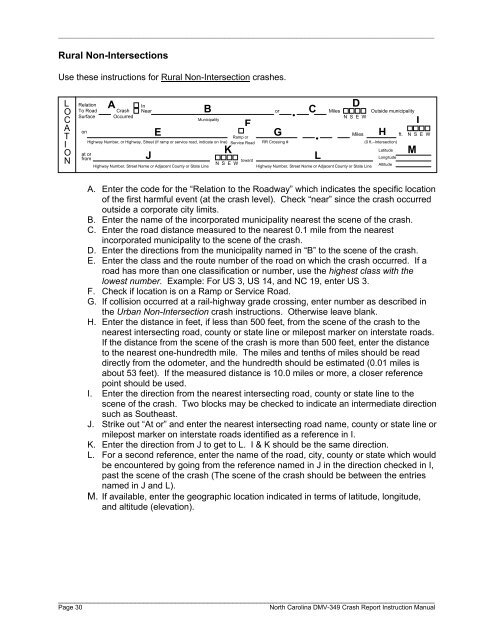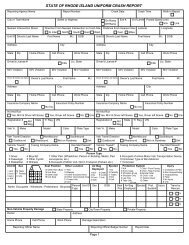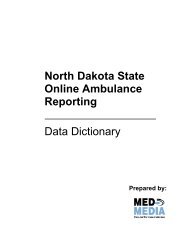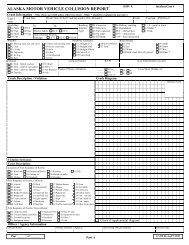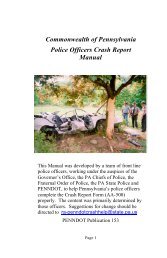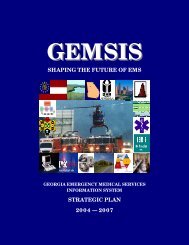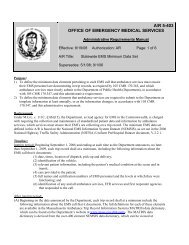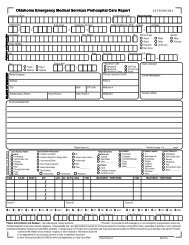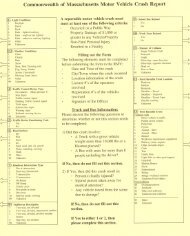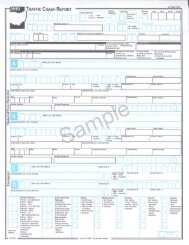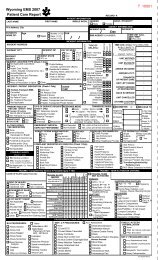North Carolina Crash Report Instruction Manual - NHTSA
North Carolina Crash Report Instruction Manual - NHTSA
North Carolina Crash Report Instruction Manual - NHTSA
- No tags were found...
You also want an ePaper? Increase the reach of your titles
YUMPU automatically turns print PDFs into web optimized ePapers that Google loves.
_____________________________________________________________________________________________Rural Non-IntersectionsUse these instructions for Rural Non-Intersection crashes.LOCATIONRelationTo RoadSurfaceonat orfromA<strong>Crash</strong>OccurredBInNear or.MunicipalityHighway Number, or Highway, Street (If ramp or service road, indicate on line)JEHighway Number, Street Name or Adjacent County or State LineKFRamp orService RoadGRR Crossing #.MilesCNDOutside municipalityN S E WMilestowardN S E WHighway Number, Street Name or Adjacent County or State LineLH(0 ft.–Intersection)LatitudeLongitudeAltitudeft.IS E WMA. Enter the code for the “Relation to the Roadway” which indicates the specific locationof the first harmful event (at the crash level). Check “near” since the crash occurredoutside a corporate city limits.B. Enter the name of the incorporated municipality nearest the scene of the crash.C. Enter the road distance measured to the nearest 0.1 mile from the nearestincorporated municipality to the scene of the crash.D. Enter the directions from the municipality named in “B” to the scene of the crash.E. Enter the class and the route number of the road on which the crash occurred. If aroad has more than one classification or number, use the highest class with thelowest number. Example: For US 3, US 14, and NC 19, enter US 3.F. Check if location is on a Ramp or Service Road.G. If collision occurred at a rail-highway grade crossing, enter number as described inthe Urban Non-Intersection crash instructions. Otherwise leave blank.H. Enter the distance in feet, if less than 500 feet, from the scene of the crash to thenearest intersecting road, county or state line or milepost marker on interstate roads.If the distance from the scene of the crash is more than 500 feet, enter the distanceto the nearest one-hundredth mile. The miles and tenths of miles should be readdirectly from the odometer, and the hundredth should be estimated (0.01 miles isabout 53 feet). If the measured distance is 10.0 miles or more, a closer referencepoint should be used.I. Enter the direction from the nearest intersecting road, county or state line to thescene of the crash. Two blocks may be checked to indicate an intermediate directionsuch as Southeast.J. Strike out “At or” and enter the nearest intersecting road name, county or state line ormilepost marker on interstate roads identified as a reference in I.K. Enter the direction from J to get to L. I & K should be the same direction.L. For a second reference, enter the name of the road, city, county or state which wouldbe encountered by going from the reference named in J in the direction checked in I,past the scene of the crash (The scene of the crash should be between the entriesnamed in J and L).M. If available, enter the geographic location indicated in terms of latitude, longitude,and altitude (elevation)._____________________________________________________________________________________________Page 30<strong>North</strong> <strong>Carolina</strong> DMV-349 <strong>Crash</strong> <strong>Report</strong> <strong>Instruction</strong> <strong>Manual</strong>


